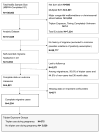Prenatal triptan exposure and parent-reported early childhood neurodevelopmental outcomes: an application of propensity score calibration to adjust for unmeasured confounding by migraine severity
- PMID: 26554750
- PMCID: PMC5071383
- DOI: 10.1002/pds.3902
Prenatal triptan exposure and parent-reported early childhood neurodevelopmental outcomes: an application of propensity score calibration to adjust for unmeasured confounding by migraine severity
Abstract
Purpose: Triptan medications are serotonin agonists used to treat migraine, a chronic pain condition highly prevalent in women of reproductive age. Data on the safety of triptans during pregnancy are scant. We sought to quantify the association of prenatal triptan exposure on neurodevelopment in 3-year-old children.
Methods: Using data from the Norwegian Mother and Child Cohort Study, we used propensity score matching to examine associations between prenatal triptan exposure and psychomotor function, communication, and temperament. We used an external validation study to perform propensity calibration to adjust effect estimates for confounders unmeasured in the main study (migraine severity, type, and maternal attitudes towards medication use).
Results: We identified 4204 women who reported migraine headache at baseline, of which 375 (8.9%) reported using a triptan greater than or equal to once during pregnancy. Children with prenatal triptan exposure had 1.37-fold greater unadjusted odds of fine motor problems (95% confidence interval (CI): 1.06-1.77), which decreased after propensity score matching (odds ratio (OR): 1.29, 95%CI 0.97-1.73) and was further attenuated after calibration (OR: 1.25, 95%CI 0.89-1.74). We observed no increased risk for gross motor or communication problems, and no differences in temperament. Adjustment for migraine severity using propensity score calibration had a moderate impact on effect estimates, with percent changes ranging from 2.4% to 50%.
Conclusions: Prenatal triptan exposure was not associated with psychomotor function, communication problems, or temperament in 3-year-old children. Adjustment for migraine severity reduced effect estimates and should be considered in future studies of the safety of triptans during pregnancy. Copyright © 2015 John Wiley & Sons, Ltd.
Keywords: child neurodevelopment; migraine; pharmacoepidemiology; pregnancy medication; propensity score calibration.
Copyright © 2015 John Wiley & Sons, Ltd.
Conflict of interest statement
summary: Drs Wood and Nordeng have no conflicts of interest.
Similar articles
-
Prenatal triptan exposure and neurodevelopmental outcomes in 5-year-old children: Follow-up from the Norwegian Mother and Child Cohort Study.Paediatr Perinat Epidemiol. 2018 May;32(3):247-255. doi: 10.1111/ppe.12461. Epub 2018 Mar 23. Paediatr Perinat Epidemiol. 2018. PMID: 29569251
-
Prenatal Triptan Exposure and Internalising and Externalising Behaviour Problems in 3-Year-Old Children: Results from the Norwegian Mother and Child Cohort Study.Paediatr Perinat Epidemiol. 2016 Mar;30(2):190-200. doi: 10.1111/ppe.12253. Epub 2015 Nov 3. Paediatr Perinat Epidemiol. 2016. PMID: 26525300 Free PMC article.
-
Association of Prenatal Exposure to Triptans, Alone or Combined With Other Migraine Medications, and Neurodevelopmental Outcomes in Offspring.Neurology. 2025 Jun 24;104(12):e213678. doi: 10.1212/WNL.0000000000213678. Epub 2025 May 21. Neurology. 2025. PMID: 40397854
-
Pregnancy outcome following prenatal exposure to triptan medications: a meta-analysis.Headache. 2015 Apr;55(4):490-501. doi: 10.1111/head.12500. Epub 2015 Feb 3. Headache. 2015. PMID: 25644494 Review.
-
Triptans in pregnancy.Ther Drug Monit. 2008 Feb;30(1):5-9. doi: 10.1097/FTD.0b013e318162c89b. Ther Drug Monit. 2008. PMID: 18223456 Free PMC article. Review.
Cited by
-
Administrative Claims Data Versus Augmented Pregnancy Data for the Study of Pharmaceutical Treatments in Pregnancy.Curr Epidemiol Rep. 2017;4(2):106-116. doi: 10.1007/s40471-017-0104-1. Epub 2017 Apr 18. Curr Epidemiol Rep. 2017. PMID: 29399433 Free PMC article. Review.
-
Longitudinal changes in neurodevelopmental outcomes between 18 and 36 months in children with prenatal triptan exposure: findings from the Norwegian Mother and Child Cohort Study.BMJ Open. 2016 Sep 13;6(9):e011971. doi: 10.1136/bmjopen-2016-011971. BMJ Open. 2016. PMID: 27625061 Free PMC article.
-
Complex patterns of concomitant medication use: A study among Norwegian women using paracetamol during pregnancy.PLoS One. 2017 Dec 28;12(12):e0190101. doi: 10.1371/journal.pone.0190101. eCollection 2017. PLoS One. 2017. PMID: 29284043 Free PMC article.
-
Use and validity of child neurodevelopment outcome measures in studies on prenatal exposure to psychotropic and analgesic medications - A systematic review.PLoS One. 2019 Jul 11;14(7):e0219778. doi: 10.1371/journal.pone.0219778. eCollection 2019. PLoS One. 2019. PMID: 31295318 Free PMC article.
-
Chronic pain during pregnancy: a review of the literature.Int J Womens Health. 2018 Apr 9;10:153-164. doi: 10.2147/IJWH.S151845. eCollection 2018. Int J Womens Health. 2018. PMID: 29692634 Free PMC article. Review.
References
-
- MacGregor EA. Headache in pregnancy. Neurol Cinics. 2012;30(3):835–66. - PubMed
-
- Lipton RB, Bigal ME, Diamond M, Freitag F, Reed ML, Stewart WF. Migraine prevalence, disease burden, and the need for preventive therapy. Neurology. 2007;68(5):343–9. - PubMed
-
- Chu MK, Buse DC, Bigal ME, Serrano D, Lipton RB. Factors Associated With Triptan Use in Episodic Migraine: Results From the American Migraine Prevalence and Prevention Study. Headache J Head Face Pain. 2012;52(2):213–223. - PubMed
-
- Nezvalová-Henriksen K, Spigset O, Nordeng H. Triptan exposure during pregnancy and the risk of major congenital malformations and adverse pregnancy outcomes: results from the Norwegian Mother and Child Cohort Study. Headache. 2010;50(4):563–75. - PubMed
Publication types
MeSH terms
Substances
Grants and funding
LinkOut - more resources
Full Text Sources
Other Literature Sources
Medical


